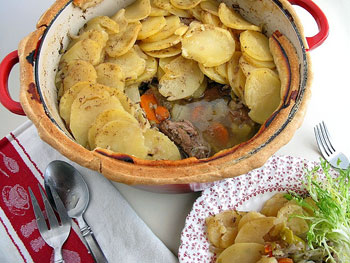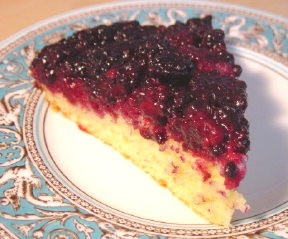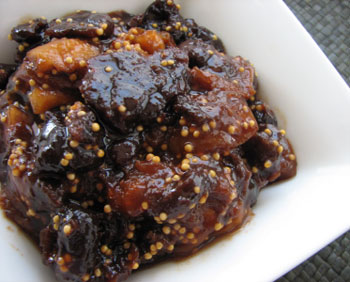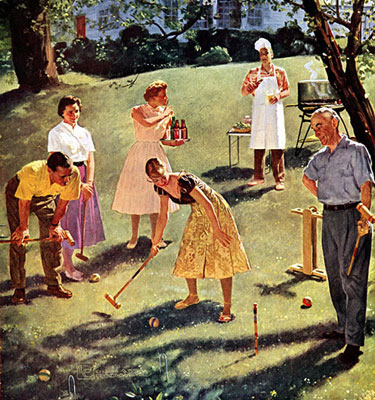 When I think of casseroles, I imagine layers and layers of meats and
vegetables slowly cooking together until fork tender. Baeckeoffe is
that casserole; it beats all other casseroles. Beef, lamb, and pork are
combined with onions, leeks, and carrots, then drowned in wine, and
slowly braised for hours in the oven until just perfect. Baeckeoffe,
which translates to baker's oven, originates from Alsace, France, a
region that has changed hands many times between France and Germany. In
many ways, especially gastronomically, it maintains a German identity.
Here you will find beer, sausages, sauerkraut, and vineyards growing
typical German grapes like Riesling and Gewürztraminer. Many dishes are
specific to this region, Baeckeoffe being one of its most famous
traditional foods.
When I think of casseroles, I imagine layers and layers of meats and
vegetables slowly cooking together until fork tender. Baeckeoffe is
that casserole; it beats all other casseroles. Beef, lamb, and pork are
combined with onions, leeks, and carrots, then drowned in wine, and
slowly braised for hours in the oven until just perfect. Baeckeoffe,
which translates to baker's oven, originates from Alsace, France, a
region that has changed hands many times between France and Germany. In
many ways, especially gastronomically, it maintains a German identity.
Here you will find beer, sausages, sauerkraut, and vineyards growing
typical German grapes like Riesling and Gewürztraminer. Many dishes are
specific to this region, Baeckeoffe being one of its most famous
traditional foods.
The most appealing features of the dish are
its minimum supervision to make and ability to feed a large, busy
family—of particular interest in olden times. As the story goes,
Alsatian women would drop off their casseroles with the local baker on
Monday, which was the day set aside for doing laundry. The baker, who
may have had many casseroles in his oven at one time, used a rope of
dough between the rim and lid of each casserole to form a tight seal
and keep in moisture. The low, steady temperature of the baker's oven
was the ideal environment for cooking the Baeckeoffe.
Retro Recipes and Traditional Fare
Retro Recipes and Traditional Fare
Blackberry Upside Down Cake
 When a wine is described as "jammy" I always think of blackberries. Rich, ripe, fruity flavors so intense they almost taste more cooked than fresh. Blackberries, when fully ripe and sweet, not sour, taste like jam to me. Jammy also means "lucky" according to an Australian English dictionary I recently consulted. I think one slice of this cake will make you feel very lucky indeed! I certainly feel lucky to have gotten the berries from my friend Alton who brought them back from his mountain cabin hideaway, Shadow Woods.
When a wine is described as "jammy" I always think of blackberries. Rich, ripe, fruity flavors so intense they almost taste more cooked than fresh. Blackberries, when fully ripe and sweet, not sour, taste like jam to me. Jammy also means "lucky" according to an Australian English dictionary I recently consulted. I think one slice of this cake will make you feel very lucky indeed! I certainly feel lucky to have gotten the berries from my friend Alton who brought them back from his mountain cabin hideaway, Shadow Woods.
I'm assuming since you are visiting this site, that you probably use the internet to find recipes. I sure do. One thing I particularly find useful are the reader comments. For example the recipes on Epicurious often have suggestions from readers on changes and improvements they have made to the posted recipes. Sometimes their suggestions make sense, though not always.
This recipe started out as one I found online, but based on reader comments, a little experimenting, and ultimately my own experience I made it my own. How different is it from the original?
Casual Carbonara
 I had a cooking breakthrough this past week that I want to share with you. Because Jill is eating more and more veganly and handling a lot of her own shopping and preparation, I end up cooking a lot of dishes for myself. And I’m finding this has liberated me in a number of ways.
I had a cooking breakthrough this past week that I want to share with you. Because Jill is eating more and more veganly and handling a lot of her own shopping and preparation, I end up cooking a lot of dishes for myself. And I’m finding this has liberated me in a number of ways.
Instead of measuring or checking the recipe for amounts, I just say to myself, “How much of that do I feel like today?” And I throw in just that much.
Without having to worry about this person’s salt problem, that person’s meat problem, this person’s wheat allergy, that person’s fat phobia – my dishes are turning out just the way I like them.
A recent carbonara is a perfect example: Carbonara is an emotional dish – it’s bacon and eggs, on pasta, with cheese, with lots of black pepper.
One theory is that the name “carbonara,” which means, “in the style of the coal-workers” really comes from the fact that the black pepper scattered on top looks like coal dust. I’m going with that theory. I think a lot of pepper makes this dish.
Allora.
Salmon Croquettes

“We would have salmon croquettes and biscuits for lunch or finely-chopped roast, drizzled in au jus gravy and bourbon colored syrup and eat the meals with delight. As domestic deity, Mary was unrivaled.” – From my memoirs...
Mrs. Mary made salmon croquettes for lunch for us many times during my childhood. Often during the summer when we were out of school and in her hair, she’d send us to the garden to pick vegetables and then we’d “help” her make lunch.
Her croquettes were more so of a crispy salmon patty, not greasy, and wonderfully delicious. Many times we would have sliced cucumbers and Vidalia’s in vinegar with them or some other fresh veggie medley...okra and tomatoes, skillet corn, or browned squash.
I’ve often tried to recreate hers, and, as with her biscuits, I just don’t hit the mark. I have discovered, though, a modern twist on this classic that is quite divine. My Mimi, a fantastic cook herself, had a hankering for salmon croquettes and I was glad to oblige – wanting to try a twist on croquettes, we began thinking...a dangerous kitchen pastime!
How to Make Mostarda
 I spent a year living in Europe, and six months of that was in Italy. Having eaten a lot of Italian food, I like to think I understand it, perhaps just a little. In fact, whenever I try to recreate an Italian dish I think back to earlier versions that I've eaten. What was it that I liked about it? What was the essence of the dish?
I spent a year living in Europe, and six months of that was in Italy. Having eaten a lot of Italian food, I like to think I understand it, perhaps just a little. In fact, whenever I try to recreate an Italian dish I think back to earlier versions that I've eaten. What was it that I liked about it? What was the essence of the dish?
In all my time in Italy, I don't remember trying mostarda. It's not surprising really because the most well-known versions come from Veneto, Lombardia and Piemonte. Most of my time was spent in Tuscany. But I still think I understand mostarda, just a bit. It's like an Italian chutney I suppose. Don't make the mistake of translating it as "mustard". Mostarda does have a little bit of mustard in it, but it's really a combination of preserved fruit in syrup with a bit of a kick. The kick comes from mustard oil, mustard essence, dry mustard, mustard seeds or some combination thereof. Other ingredients include sugar or honey, wine, vinegar and sometimes citrus juice.
When I am developing a recipe, I often look for several variations then strike off on my own. The recipes I found for mostarda varied greatly--some used dry fruit, others fresh fruit. Some cooked slowly others cooked quickly. Some had lots of mustard, others barely a pinch. My own experiment lead me to this conclusion: Mostarda is very forgiving and can easily be made to your own taste. You can taste as you go and make changes.
More Articles ...
Welcome to the new One for the Table ...
Our Home Page will be different each time you arrive.
We're sure you'll find something to pique your interest...


